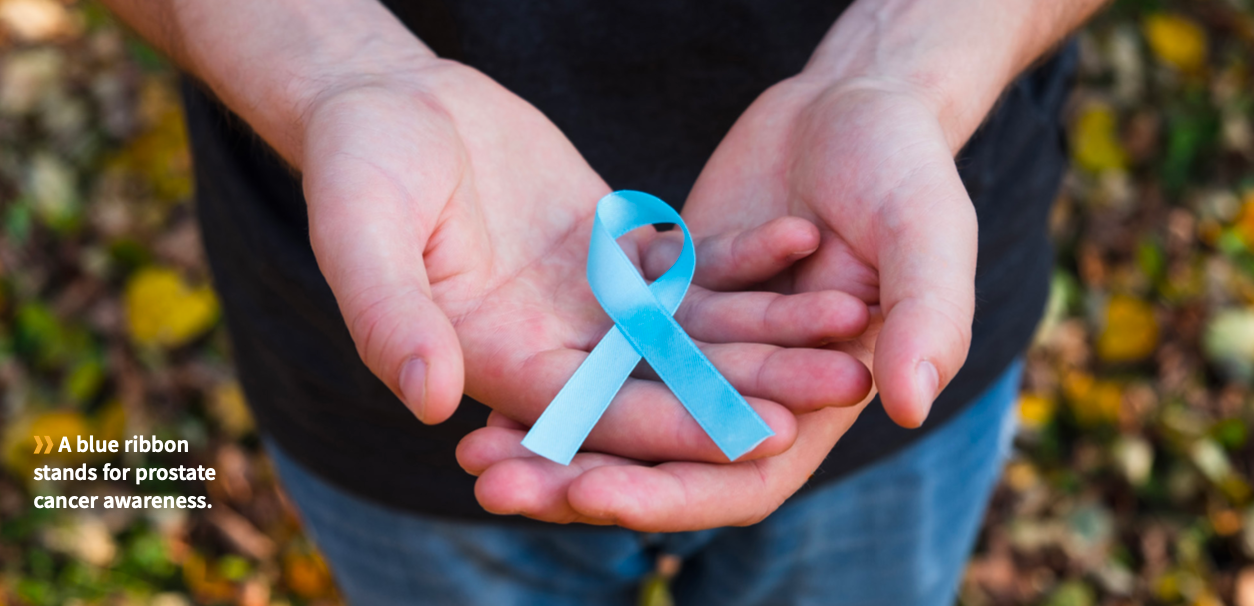Article
Prostate Cancer
Understanding prostate cancer.
In many cases, prostate cancer is relatively slow-growing, often taking years to become large enough to be detectable and even longer to spread outside the prostate, or metastasize. Some cases are more aggressive and need more urgent treatment. Fortunately, there are many treatment options for all stages of the disease.
WHAT IS PROSTATE CANCER?
Prostate cancer starts in the prostate, a small gland located below the bladder that is responsible for secreting one of the components of semen. Prostate cells grow out of control and become cancerous, stimulated by male hormones, including testosterone.
WHAT ARE THE RISK FACTORS FOR PROSTATE CANCER?
Risk factors for prostate cancer are increasing age, African ancestry, a family history of the disease and certain inherited genes. Lifestyle matters, too: There is evidence that smoking increases the risk of fatal prostate cancer and excess body weight increases the risk of aggressive and fatal prostate cancer.
WHAT ARE THE SYMPTOMS OF PROSTATE CANCER?
Prostate cancer rarely causes symptoms. When it does, they can include frequent urination or other urinary issues, problems with erection or ejaculation, weakness or numbness in the legs and feet and pressure or pain in the rectum or pelvis. Because symptoms are uncommon, it’s important to make a prostate cancer screening plan with your doctor.
HOW IS PROSTATE CANCER DIAGNOSED AND STAGED?
The prostate-specific antigen (PSA) blood test and digital rectal exam (DRE) can be used to detect prostate cancer when no symptoms are present. They can help catch the disease at an early stage when treatment may be more effective and potentially have fewer side effects.
Average-risk men should talk to their doctor about PSA screening at 45; men of African descent and those with a strong family history of prostate or other cancers should have this discussion at 40.
If the PSA is elevated, a doctor may order an MRI or other tests. A needle biopsy, commonly done through the rectum, is needed to establish the diagnosis. If cancer is detected, doctors assess its stage using five important pieces of information:
- How much and how quickly PSA rises over time;
- How aggressive the cancer cells look under a microscope, expressed as a Gleason score (range of 6-10; 10 is the most abnormal) or a Grade Group score (range of 1 to 5);
- Number of biopsy cores, or samples, with cancer;
- Whether the cancer cells are limited to inside the prostate or have spread outside into the neighboring pelvic areas, and
- Whether the cancer has invaded lymph nodes and/or spread to more distant parts of the body.
Localized and locally advanced prostate cancer (cancer that is in the prostate or the region around it) is assigned a risk group (ranging from very low to very high) based on these criteria. Patients diagnosed with high-risk or metastatic cancer may receive a recommendation to have additional testing of their tumor for gene mutations (e.g., alterations to BRCA1 or BRCA2), as well as genetic testing for inherited cancer risk.
HOW IS PROSTATE CANCER TREATED?
There is no “one size fits all” approach to treatment of prostate cancer. Treatment options depend upon the risk group and patient factors and preferences.
A patient diagnosed with localized or locally advanced prostate cancer has three primary treatment options:
- Active surveillance: Follow the cancer closely with regularly scheduled PSA checks, DREs and biopsies so that definitive treatment is administered only if and when necessary.
- Surgery: Remove the entire prostate gland and seminal vesicles (radical prostatectomy). This is an option for men with intermediate- or high-risk cancer that has not spread.
- Radiation therapy: Precisely kill cancer cells with ionizing radiation. Like surgery, it is very effective for localized or locally advanced prostate cancer and has the same cure rate as surgery.
For men whose disease appears more aggressive, certain treatment combinations may be recommended. Hormone therapy may be added. Also known as androgen deprivation therapy (ADT), this is medication to stop testosterone from being produced or to directly block it from acting on prostate cancer cells.

In some cases, prostate cancer is already aggressive and has spread outside the prostate (metastatic) at the time of initial diagnosis. Furthermore, in men who already have been treated for prostate cancer, it can recur. Fortunately, men with advanced prostate cancer have several treatment options, including ADT alone or in combination with newer, “second-generation” anti-androgen medications. For patients with a low volume of metastatic disease at diagnosis, radiation therapy may be combined with ADT. Chemotherapy drugs can help manage pain and may improve survival in patients with metastatic disease. Other, newer treatments include targeted drugs known as PARP inhibitors (approved in 2020), immunotherapy drugs known as checkpoint inhibitors, a prostate cancer vaccine (sipuleucel-T) and treatments targeting cancer in the bones, such as radium-223.
WHAT ARE THE POTENTIAL SIDE EFFECTS OF TREATMENT?
Because the prostate is close to several vital structures, localized prostate cancer and its treatments can disrupt normal urinary, bowel and sexual functioning. Prostatectomy may result in urinary incontinence or leakage. Nearly all men will have some form of leakage immediately after the surgery, but this will improve over time and with strengthening exercises. Radiation therapy may cause a mild increase in urinary frequency and urgency and/or the need to urinate at night.
Erectile dysfunction remains the most common side effect after treatment. Fortunately, there are many excellent treatments for managing erectile function. After surgery or radiation, men are unlikely to be fertile.
Treatment of advanced disease carries other side effects. ADT causes side effects related to reversing all of the normal functions of testosterone. Although most men may experience only a few of these symptoms, the list of potential effects is long, including hot flashes, decreased sexual desire, metabolic changes and changes in mood and thinking. For chemotherapy, reactions to drugs can vary widely, so it’s important to pay attention to any side effects — the most serious, but uncommon, being fever with a low white blood cell count.
HOW DOES PROSTATE CANCER AFFECT A PATIENT’S LIFE?
The two most common side effects of treatment for localized prostate cancer are incontinence and erectile dysfunction. They can be managed and may be temporary, but for those affected, learning to live with these issues can be challenging. Men on active surveillance to monitor early-stage prostate cancer face a small risk that the disease will become aggressive and spread, and some may feel worried about this.
For those living with prostate cancer, it’s important to make mindful everyday choices about diet and lifestyle. There is growing scientific evidence that good nutrition and moderate to vigorous exercise may actually slow the growth and progression of prostate cancer.
WHERE IS HELP AVAILABLE?
The Prostate Cancer Foundation (pcf.org; 1-800-757-2873) offers extensive information about the disease and patient resources for every stage of the journey. For more details on the topics mentioned above, download the Prostate Cancer Patient Guide. Check our list of resources online at curetoday.com/journey for additional organizations that can offer help and guidance.




